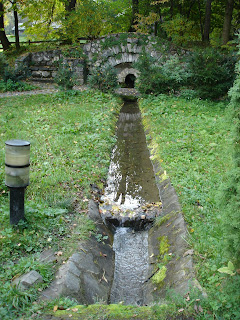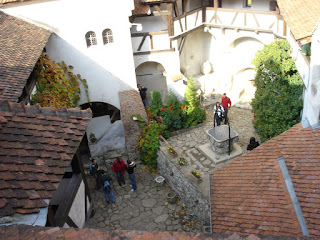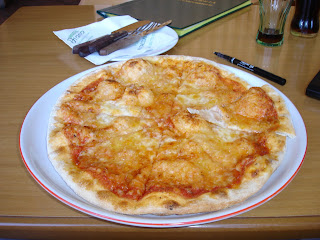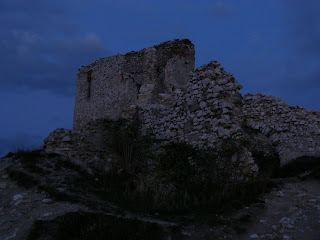
I’m a sucker for a scary story. That fascination is perhaps most notable in my penchant for the series of
Of the Dead films produced by writer/director George Romero over the past 30 years. Both an artist and a social scientist, Romero has always intended the slowly-moving, cannibalistic, reanimated corpses of his films to provide social commentary in representing some identified marginalized “outsider” group of people whom the “living” (i.e. the wealthy, the privileged, the elite) would rather not engage, and further fear will come to “get them”, consume them, and take away their “life” and privilege if they get too close. Zombies look human, but are not treated as such by those still living, and the tendencies of the walking dead to hunger for the flesh of the living does not make them desirable company. As a result, the living exist in ever-shrinking and more sophisticated fortresses while roving hordes of ghoulish dead stare in from the outside, hungry for what they see and yet find themselves unable to attain.
For my part, I grew up very much in the world of the “living”. The son of two attorneys, one a Prosecutor, City Attorney and Judge, the other a clerk for two Federal Judges, I never considered that there might be another side to the world. And yet, through my own curiosity and ever-deepening forays into the world of the “dead” through short-term mission ventures in 18 countries, inner-city dwelling, and advocacy and community development work, i found myself one day awakening to the notion that whether bitten or bidden, I had become “dead” myself. In the last ten years, I have scrubbed toilets as a janitor and thrown papers for a local newspaper to augment my full-time job, only to engage the desperation of being financially “short” at the end of each month. My wife and I have served discarded, pregnant, teen-aged girls in Michiana as full time “house parents” for a local teen maternity home, and witnessed the ripple-effects of abandonment and social stigma on each of the young women’s lives. I have worked to engineer holistic systems of care with Granger Community Church to help men, women and children who are locked in the bonds of generational poverty to acquire faith, food, vocational training, medical help, high school equivalency and positive relationships within their community. I have walked for the past 6 years alongside Indian men and women planting churches in remote contexts where people sell their lives and their families to bonded slave owners for the cost of a few dollars, and, because of the oppressiveness of the reinforced caste-system, have little hope of changing their plight. I have done all these things and more with an ever-growing sense of powerlessness at my inability to help overturn the systems and structures that have prompted such bonds, and find that I am now unable to see the injustice and disparity between the “living” and the “dead” without myself beginning to feel… hungry.
Hungry for Awareness. Whether in government (local or national), corporations (domestic or multi-national) or community-based organizations and initiatives (churches, faith communities, NGO’s, etc), the oppressed people I engage every day are simply not aware of how best to navigate their own transformation to the land of the living. In addition, continual marginalization (overtly or covertly) by the “living” keeps the mob just out of view enough to prevent true efforts at bridge-building, advocacy, and grass-roots motivated change.
Hungry for Organization. In both the US or environments like India, I have been continually frustrated by the lack of concentrated or coordinated efforts between businesses, NGO’s, government and community organizations to help the “dead”. Few initiatives are backed by memoranda or contracts with specific and measurable metrics (what I call “relationships with teeth”), and program isolation and lack of coordination prevents sustainable change from happening. The result of both is that the “dead” stay dead, and all for what is, in many instances, a simple lack of adequate organization, contractual understanding, accountability and defined deliverables between organization types.
Hungry for Justice. Whether in bonded slave, sex trafficking or sweatshop environments in India or the red tape surrounding the working poor, ex-offender and welfare states of the “dead” that I have engaged in South Bend and Chicago, the simple reality is that most of the “dead” do not know what rights they have, or how to access them. In addition, the gap between legislation and enforcement is daunting at a government level (India, for instance, has anti-slavery legislation, but enforcement is lax if not totally nonexistent), and in the instance of corporations that are willing to be socially responsible, there is often too little concern or knowledge about the holistic concerns that govern the poor and marginalized to truly help them to be healthy or deliver to their potential.
And so I am setting out to gain the ability to combat those barriers which I have identified in my work to help the “dead” thus far. Specifically, the fact that the bulk of those barriers center around policy, systems and infrastructure supporting effective grass-roots initiatives lends me to my current path of pursuing some course to better enhance my effectiveness. I may now be one of the “dead” myself, but I walk forward not with the same mob mindlessness that is typical of those staggering corpses in Romero’s works. Rather, I remember “life”. I still remember what is possible, and have not yet succumbed to the numbness that layers of poverty and injustice can heap upon one until they forget their humanity altogether. I wish to add an element of focused intellect and skill to the horde… a “smarter zombie” of sorts, capable of rallying the mob and giving to it a direction and machination that will begin to build its return to the land of the “living” while simultaneously working with the “living” themselves to become aware of their privilege, and willingly and generously begin to open the gates of their walled privileges and embrace those standing and staring hungrily from the outside.
Through all of this, achieving any skill for myself is of little value if I do not further disseminate the benefits of that skill to those others in the mob, and facilitate the continual increasing, investing and slowly building of their momentum. In the end, I suppose, that my hope is that mob itself can become “smart”. And once we are “smart”, we will no longer be easily dismissed by the shrinking numbers of “living” in the world. Further, our flesh will no longer rot, our stagger no longer be plagued with mindlessness, our hunger no longer focused on violently consuming that which we see around us because we will have access to the same tangible and intangible benefits shared by the “living”. Our rage will subside as we are treated not as a faceless and undesirable mob ever encroaching from the outside, but rather as respected equals in the land of the “living”, with a full and equitable place in the world around us.

 I’m a sucker for a scary story. That fascination is perhaps most notable in my penchant for the series of Of the Dead films produced by writer/director George Romero over the past 30 years. Both an artist and a social scientist, Romero has always intended the slowly-moving, cannibalistic, reanimated corpses of his films to provide social commentary in representing some identified marginalized “outsider” group of people whom the “living” (i.e. the wealthy, the privileged, the elite) would rather not engage, and further fear will come to “get them”, consume them, and take away their “life” and privilege if they get too close. Zombies look human, but are not treated as such by those still living, and the tendencies of the walking dead to hunger for the flesh of the living does not make them desirable company. As a result, the living exist in ever-shrinking and more sophisticated fortresses while roving hordes of ghoulish dead stare in from the outside, hungry for what they see and yet find themselves unable to attain.
I’m a sucker for a scary story. That fascination is perhaps most notable in my penchant for the series of Of the Dead films produced by writer/director George Romero over the past 30 years. Both an artist and a social scientist, Romero has always intended the slowly-moving, cannibalistic, reanimated corpses of his films to provide social commentary in representing some identified marginalized “outsider” group of people whom the “living” (i.e. the wealthy, the privileged, the elite) would rather not engage, and further fear will come to “get them”, consume them, and take away their “life” and privilege if they get too close. Zombies look human, but are not treated as such by those still living, and the tendencies of the walking dead to hunger for the flesh of the living does not make them desirable company. As a result, the living exist in ever-shrinking and more sophisticated fortresses while roving hordes of ghoulish dead stare in from the outside, hungry for what they see and yet find themselves unable to attain. 























































